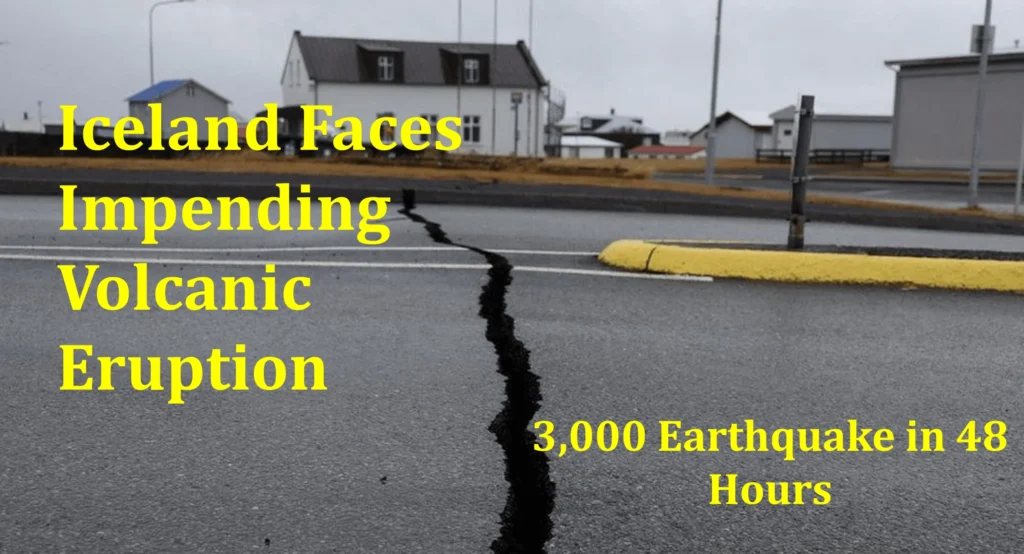
Presently Iceland has been facing a major seismic crisis. The threat of Iceland’s Volcanic Eruption and Earthquakes has led the government to declare a state of emergency and organize evacuations. The beautiful southwestern Reykjanes peninsula of Iceland has become the center of attention experiencing earthquakes that are causing worries, about a potential volcanic eruption, in the near future.
A Nation on Edge: Government Declares State of Emergency
The unfolding events have thrust Iceland into a state of uncertainty and urgency. The Icelandic government, recognizing the severity of the situation, declared a state of emergency in response to the intense seismic activity in the Sundhnjukagigar region, north of Grindavik. The Department of Civil Protection and Emergency Management sounded the alarm, emphasizing the potential escalation of earthquakes that could lead to a volcanic eruption.
Presidential Perspective: Gratitude Amidst Destruction
Amidst this upheaval President of Iceland Guðni Th. Jóhannesson spoke to RÚV expressing his gratitude that despite the damage, to homes and buildings no lives have been lost. He acknowledged that they are still, in the midst of the situation but remained hopeful that everything could be restored. President Jóhannessons words reflect the strength of the people when confronted with natures immense power.
Magnitude Unleashed: Thousands of Earthquakes Recorded
The Icelandic Met Office (IMO) has been diligently tracking the seismic activity, revealing a staggering report of over 3,000 earthquakes within the past 48 hours. The magnitude and frequency of these tremors have heightened concerns, with experts suggesting the possibility of a volcanic eruption in the coming days.
On a fateful Friday, two robust earthquakes, the largest measuring a magnitude of 5.2, reverberated across the country’s southern coast. The tremors reached as far as the capital, Reykjavik, 40km away, leaving residents in awe and prompting the realization that nature’s power knows no bounds.
Navigating the Unpredictable: Calls for Self-Control Amidst Nature’s Fury
President Jóhannesson, acknowledging the uncontrollable force of nature, added, “We cannot control the power of nature, but we can control our own reactions.” This sentiment underscores the collective responsibility to respond with resilience and preparedness in the face of the unpredictable.
Reykjanes Peninsula: A Swarm of Tremors
Local media reports reveal that the Reykjanes Peninsula has been subjected to over 22,000 earthquakes since October 25, creating an atmosphere of unease and anticipation. A notable concern arises from a potential dike formation beneath the town of Grindavík, raising the specter of a mandatory evacuation. Despite the absence of signs indicating magma reaching the surface, authorities caution residents about the imminent possibility of an emergency evacuation.

Magma Mysteries: Unraveling the Depths
As the crisis unfolds, the exact location where magma might breach the surface remains a mystery. Indications, however, suggest a significant volume of magma, surpassing previous observations in recent eruptions at Mt. Fagradalsfjall. Volcanologist Þorvaldur Þórðarson, speaking to RÚV, voiced a sense of urgency, stating, “I don’t think it’s long until an eruption, hours or a few days.”
Eruptions of the Past: Learning from History
Iceland’s rich volcanic history, marked by eruptions at Mt. Fagradalsfjall in 2021 and subsequent events in 2022 and 2023, provides context to the current situation. The island, nestled atop the Mid-Atlantic Ridge, remains an active hotspot for geological activity.

Tourism Disruptions: Blue Lagoon Temporarily Closes its Gates
The seismic swarm has not only disrupted the lives of Icelanders but has also impacted tourism. The iconic Blue Lagoon geothermal spa, a magnet for visitors, has been forced to temporarily close its doors for a week. This unexpected closure reflects the broader implications of natural disasters on the nation’s economic pillars.
Europe’s Volcanic Epicenter: Iceland’s Unique Geological Landscape
Iceland’s designation as Europe’s volcanic epicenter is underscored by its possession of over 30 active volcanic systems. The nation’s geological intricacies and the delicate balance between human civilization and natural forces are once again brought to the forefront.
Evacuation Preparations: A Nation Braces for Impact
Evacuation plans are underway, with Grindavik, home to about 4,000 people, particularly in focus. The village’s proximity to the seismic epicenter raises concerns, and authorities are taking preemptive measures to ensure the safety of residents.
Geothermal Facilities at Risk: Svartsengi Plant on Alert
Nearby infrastructure, including the Svartsengi geothermal plant, faces potential risks. This power station plays a role by providing electricity and water to around 30,000 people living on the Reykjanes peninsula. There are plans, in place to ensure the safety of the facility and its employees in case of an eruption.
The Road Ahead: Uncertain Horizons
As seismic activity continues to unfold, the people of Iceland confront an uncertain future. The potential eruption, with its unpredictable trajectory, reminds us of the volatile forces beneath the Earth’s surface.
Conclusion: Nature’s Unyielding Power
In the coming days, Iceland will navigate through the complexities of an impending volcanic eruption. The collaboration, between the country’s readiness, ability to bounce back and scientific knowledge will have a role in minimizing the effects of this event. As people, around the globe observe Iceland serves as an example of the yet uncertain powers that shape our world. The delicate dance between nature and civilization unfolds, reminding us of the perpetual need for preparedness in the face of Earth’s unyielding power.
